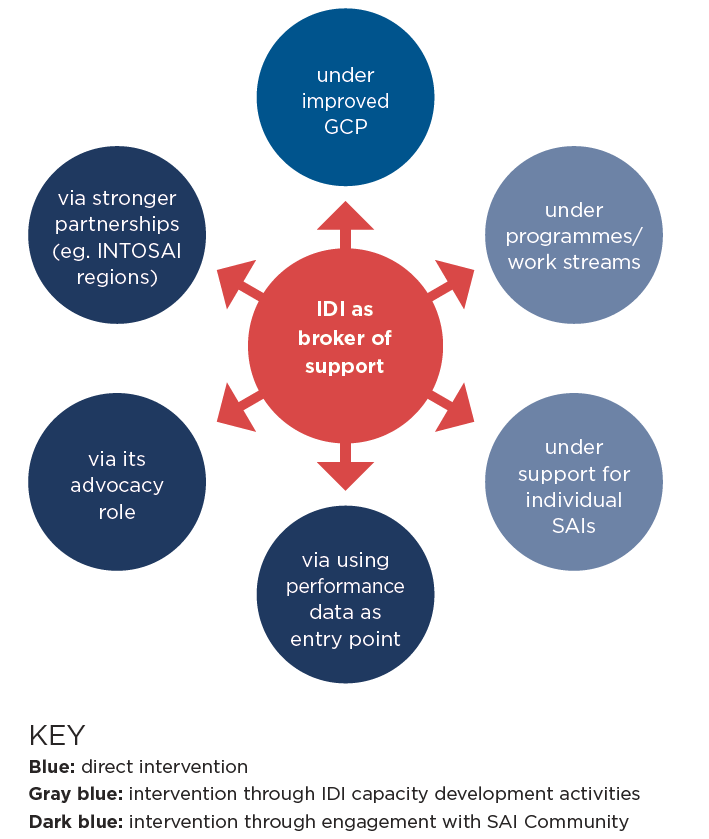About IDI
Our Cross-Cutting Priorities
Our Results
Meet the IDI Board
IDI's Board is composed of ten members from different supreme audit institutions. Get to know them better in our "Meet the Board" series.

For IDI to deliver effective support through its four work streams and bilateral efforts, there must be strong global foundations that strengthen the role and effectiveness of SAIs. IDI, in cooperation with the INTOSAI and donor community, has identified four key focus areas, or "foundations", that can collectively create a strong global basis for supporting SAIs and enhancing the value and benefits they deliver to citizens.
The four key foundations are:
The Global Foundations Unit (GFU) coordinates activities within these four foundations, both through IDI and the INTOSAI-Donor Cooperation.
The background and goals for each of the four foundations, as outline in IDI's current Strategic Plan, can be found below.
Recognising that IDI’s vision is shared with that of many partners, IDI will seek to engage in strategic partnerships that enable IDI and its partners to work together to achieve shared goals. As an INTOSAI body, IDI always has and will continue to partner with other INTOSAI bodies. In addition, IDI will also partner with organisations outside of INTOSAI. IDI considers the following groups of partners as essential:
As an INTOSAI body with a global focus, engaged in both policy formulation and SAI-level implementation, IDI is uniquely placed to measure and monitor SAI performance and support at a global level. The rationale for engagement in this area stems from the need for global information on SAI performance and priorities, the need to ensure support is effectively coordinated, the need to identify the results from support to SAIs, and to learn lessons on the effectiveness of support.
IDI envisages the following components under Measure and Monitor SAI Performance and Support:
For IDI, brokering support is about the facilitation of matching and connecting SAIs with suitable partners, and empowering SAIs to better articulate their support needs. Brokering support can be done through a formal process, like the Global Call for Proposals (GCP), or more informally through all IDI’s work. IDI will put more emphasis on bringing the right partners together in support of SAIs and INTOSAI Regions (through peer-to-peer, donor support etc.).

As the figure shows, IDI will broker support through a targeted intervention (GCP), which would be a revised approach to scaling up support through helping to match SAI needs with donor/ peer-support capabilities. IDI could also continue to broker support less directly through its work streams and individual SAI support, by facilitating contact with donor organisations and other providers of support. A less direct method is for IDI to spot opportunities informally through its data gathering on performance, its partnership engagement and advocacy work.
Communications and advocacy are vital to maximise the effectiveness of the IDI Strategic Plan. A separate but complementary IDI Global Communications and Advocacy Strategy7 reinforces the vision, mission and strategic priorities set out in the Strategic Plan at global level.
IDI defines advocacy as a process that involves empowering and facilitating the efforts of stakeholders in changing existing laws, practices, ideas, and distributions of power and resources. It is both about changing specific decisions affecting people’s lives and changing decision making processes, so they are more effective, accountable and inclusive. IDI applies advocacy approaches to support the sustainable enhancement of SAI independence, resources, capacity, performance and impact. IDI advocates for implementation of international standards for and by SAIs, and for SAIs to engage in emerging issues relevant to citizens.
The INTOSAI-Donor Cooperation has asked IDI to incorporate the operational work to achieve the objectives of the Memorandum of Understanding between the Donor community and INTOSAI. In this respect, IDI will specifically advocate for support being SAI-led, well-coordinated and harmonised around the SAI’s own strategic planning. IDI will work closely with INTOSAI and the Donor community to leverage their engagement in promoting these principles.
As a member of the INTOSAI family with a distinct role as an implementing body, IDI will coordinate, work and build synergies with INTOSAI entities and contribute to the INTOSAI Strategic Plan through its own communication and advocacy efforts.
IDI will focus on the following communication objectives:
IDI will target its audience by directly addressing relevant stakeholders via appropriate communication channels and by engaging with change agents that have the potential to act on behalf of IDI. IDI will incorporate gender into its advocacy and behavioural change work. Behaviour change will not only encompass good development cooperation practices, but also communicate the benefits of diversity for SAIs and the countries they operate in. This can include identifying, developing, and disseminating success stories which highlight the role of women and gender issues in SAIs, and their contributions to successful capacity development efforts.